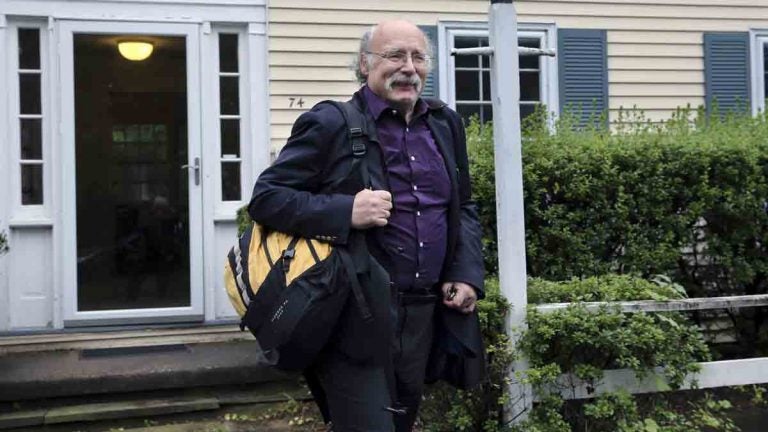Princeton professor shares in the 2016 Nobel Prize in Physics

Princeton University physics professor F. Duncan Haldane leaves his home after it was announced that he and two others have been awarded the 2016 Nobel Prize in Physics early Tuesday
Princeton University professor F. Duncan Haldane has been awarded the 2016 Nobel Prize in Physics for research that could result in improved materials for electronics or quantum computers.
Haldane, the Eugene Higgins Professor of Physics who joined the Princeton faculty in 1990, shares the prize with David Thouless of the University of Washington and J. Michael Kosterlitz of Brown University. The three are honored for breakthroughs they made in the 1970s and ’80s.
Watch Live Stream of a Princeton University news conference at 1:30 p.m., featuring Duncan Haldane
The Royal Swedish Academy of Sciences said their work opened the door to a previously unknown world where matter can assume unusual states or phases.
“Their discoveries have brought about breakthroughs in the theoretical understanding of matter’s mysteries and created new perspectives on the development of innovative materials,” the academy said.
The $930,000 award was divided with one half going to Thouless and the other to Haldane and Kosterlitz for “theoretical discoveries of topological phase transitions and topological phases of matter.”
Topology is a branch of mathematics that describes properties of objects.
The judges said there is now hope that “topological materials” could pave the way for new generations of electronics or quantum computers that are much more powerful than current computer systems.
Nobel judges often award discoveries made decades ago to make sure they withstand the test of time.
Thouless, 82, is a professor emeritus at the University of Washington. Haldane, 65, is a physics professor at Princeton University in New Jersey. Kosterlitz, 73, is a physics professor at Brown University in Providence, Rhode Island and currently a visiting lecturer at Aalto University in Helsinki.
Haldane said he found out about the prize through an early morning telephone call.
“My first thought was someone had died,” he told The Associated Press. “But then a lady with a Swedish accent was on the line. It was pretty unexpected.”
Kosterlitz, a dual U.K.-U.S. citizen, said he got the news in a parking garage while heading to lunch in Helsinki.
“I’m a little bit dazzled. I’m still trying to take it in,” he told AP.
While most people are familiar with objects in three dimensions, the Nobel laureates analyzed materials so thin they have only two dimensions, or even one.
Scientists had once been skeptical that any interesting atomic-scale behavior takes place in these settings, but the Nobellaureates proved them wrong, said Phillip Schewe, a physicist and writer at the University of Maryland in College Park.
For example, Kosterlitz and Thouless showed that, against expectations, two-dimensional materials could conduct electricity without any loss to resistance. That property is called superconductivity.
Kosterlitz said he was in his 20s at the time and that his “complete ignorance” was an advantage in challenging the established science.
“I didn’t have any preconceived ideas,” he said. “I was young and stupid enough to take it on.”
Their analysis relied on topology, which is the mathematical study of properties that don’t change when objects are distorted. A doughnut and a coffee cup are equivalent topologically because they each have exactly one hole. In topology, properties change only in whole steps; you can’t have half a hole.
Prize committee member Thors Hans Hansson explained the concept by holding up a cinnamon bun, a bagel and a pretzel with two holes in it to reporters in Stockholm.
Thouless explained an experiment conducted with a very thin layer of material. Its electrical resistance varied in response to changes in a magnetic field, but while the strength of the field was changed smoothly, the resistance changed in sharply defined steps. This effect is so precise that it is now used to define the unit of electrical resistance, the ohm.
Nobel committee member David Haviland said this year’s prizewas more about theoretical discoveries even though they may result in practical applications.
“Topology is a very abstract branch of mathematics which isn’t used so frequently in physics,” Haviland said. “But these theoreticians have come up with a description of these materials using topological ideas, which have proven very fruitful and has led to a lot of ongoing research about material properties.”
Haldane said the award-winning research is just starting to have practical applications.
“The big hope is that some of these new materials could lead to quantum computers and other new technology,” he said.
Kosterlitz was not so sure.
“I’ve been waiting for my desktop quantum computer for years, but it’s still showing no signs of appearing,” he said. “At the risk of making a bad mistake, I would say that this quantum computation stuff is a long way from being practical.”
This year’s Nobel Prize announcements started Monday with the medicine award going to Japanese biologist Yoshinori Ohsumi for discoveries on autophagy, the process by which a cell breaks down and recycles content.
The chemistry prize will be announced on Wednesday and theNobel Peace Prize on Friday. The economics and literature awards will be announced next week.
Besides the prize money, the winners get a medal and a diploma at the award ceremonies on Dec. 10, the anniversary of prizefounder Alfred Nobel’s death in 1896.
The Associated Press contributed to this report.
WHYY is your source for fact-based, in-depth journalism and information. As a nonprofit organization, we rely on financial support from readers like you. Please give today.




